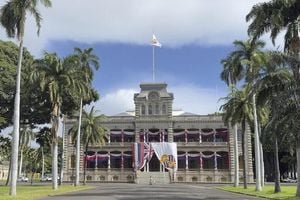Travelers flying into and out of Ronald Reagan Washington National Airport on August 18, 2025, found themselves facing an unexpected and confusing disruption. The morning began with a mysterious fire alarm sounding in the airport’s air traffic control tower—a critical nerve center for one of the busiest airports in the nation’s capital. The incident led to a complete halt of all air traffic in and out of Reagan National, stranding passengers, delaying flights, and sparking questions about the cause and the airport’s recent track record on safety and security.
According to the Federal Aviation Administration (FAA), the disruption began at 10:45 a.m. when the fire alarm forced the immediate evacuation of the control tower. Flights were stopped cold, with inbound planes left circling and outbound flights grounded on the tarmac. The FAA later clarified that there was no actual fire inside the tower, but the agency did not reveal what had set off the alarm in the first place. By noon, the tower was declared fully operational, and staff returned to their posts, but the ripple effects of the shutdown lasted much longer.
FlightAware, a flight-tracking service, reported that one incoming flight—Delta Air Lines 2476 from Detroit Metropolitan Wayne County Airport—was forced to circle the area because it could not get a landing vector from the tower. The pilot of DL2476 reportedly told passengers that the staff had been returned to the tower, providing some reassurance to those on board. But for many travelers on the ground and in the air, the lack of information was frustrating. As one passenger confirmed, “The pilot told us that staff had been returned to the tower,” echoing the confusion and relief felt by many on Monday.
The disruption continued to affect flights well into the afternoon. The FAA said that even after operations resumed at midday, flights into Reagan National were delayed by more than half an hour due to the backlog of traffic. It was a chaotic scene, with passengers crowding terminal gates and airline staff scrambling to rebook missed connections. For many, it was a stark reminder of how quickly modern travel can grind to a halt when the systems behind the scenes falter—even for just over an hour.
The cause of the fire alarm remains a mystery. The FAA has yet to disclose what triggered the evacuation. Unconfirmed reports suggested a technical glitch or possible false alarm, but with no official word from the agency, speculation continues. According to Express U.S., the incident followed a recent spate of unsettling events at the airport. Just months earlier, on March 27, an altercation between two air traffic controllers in the same tower escalated into a physical fight, leading to charges against one controller, Damon Marsalis Gaine, who was placed on administrative leave pending a federal investigation. The FAA confirmed in a statement that Gaine had not publicly addressed the situation.
This isn’t the first time Reagan National Airport has been at the center of aviation safety concerns. The airport was the site of the nation’s deadliest plane crash since 2001, when an Army helicopter collided with an American Airlines jet in the skies over the capital, killing all 67 people aboard both aircraft. That tragedy, combined with a series of other close calls and incidents in the years since, has fueled ongoing fears about the safety and reliability of air travel in and out of Washington, D.C.
Monday’s incident, while not resulting in any injuries or direct danger to passengers, nevertheless highlighted the fragility of airport operations and the importance of robust safety protocols. “All flights out of the airport have been grounded until noon,” reported Express U.S., capturing the scale of the disruption. The event also raised questions about the resilience of the airport’s emergency response systems. If a single fire alarm—real or false—can bring the entire operation to a standstill, what does that say about preparedness for a genuine emergency?
For travelers, the experience was a mix of inconvenience, anxiety, and resignation. Some passengers took to social media to share their stories, posting photos of crowded terminals and delayed departure boards. Others expressed frustration at the lack of clear communication from airlines and airport officials. “Flights into the airport continued to be delayed more than half an hour into midafternoon because of heavy traffic after flights were stopped between 10:45 a.m. and noon,” the FAA explained, but for those waiting, it was small comfort.
Outside the immediate chaos, the incident comes at a time when the aviation industry is already under scrutiny for safety lapses and near-misses. In recent months, major airlines have faced their own operational headaches, from IT meltdowns to emergency landings. An unrelated but notable example occurred on April 5, 2025, when an Airbus A350-900 departing from Tahiti for Los Angeles was forced to make an emergency turnaround in the middle of the Pacific Ocean. The plane landed safely back on the island after more than six hours in the air, but the cause of that emergency remains unclear. As Express U.S. noted, such incidents—whether due to engine failure, weather, or technical issues—underscore the many variables that can disrupt modern air travel.
Back in Washington, the focus has now shifted to understanding what happened in the control tower and ensuring it doesn’t happen again. The FAA has been contacted for further information, but as of Tuesday, no new details had emerged about the root cause of the fire alarm or whether any changes would be made to protocols as a result. For airport staff, who have already endured the stress of a high-profile altercation in the tower earlier this year, the incident is another reminder of the pressures and responsibilities they face every day.
Despite the disruption, flights at Reagan National eventually returned to their usual rhythm. By late afternoon, delays began to ease and the backlog of grounded planes slowly cleared. Yet the memory of Monday’s confusion lingers for many—a small but telling episode in the complex world of aviation, where even a single alarm can ground a city’s air traffic and remind everyone just how much we rely on the unseen systems that keep us moving.
As the investigation continues, travelers and officials alike are left to wonder: what really happened in the tower that morning, and how can the airport ensure smoother skies ahead?




